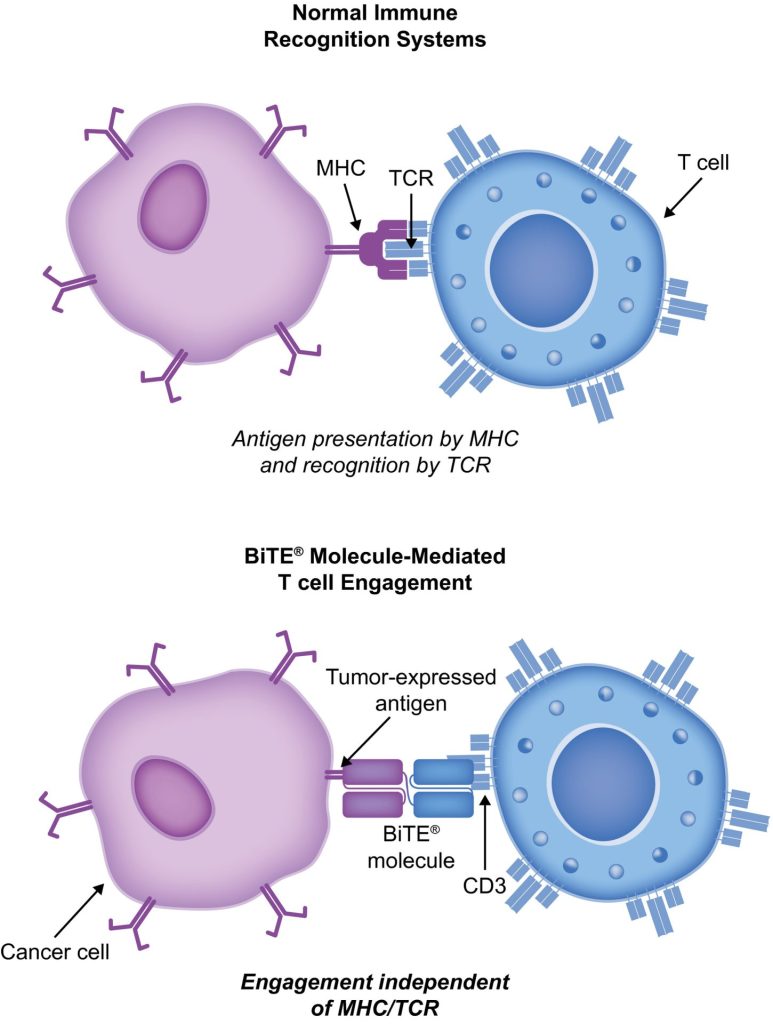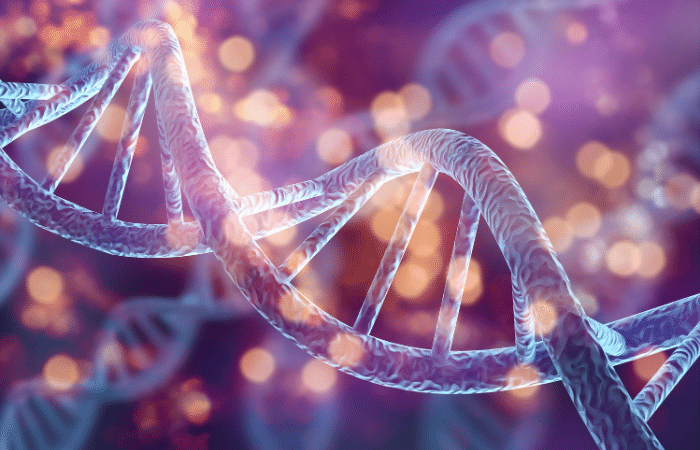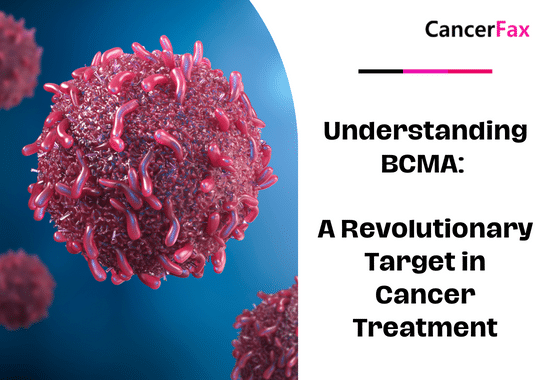Immuno-oncology is a way to treat cancer by using the body’s immune system. BiTE (bispecific T-cell engager) technology is a targeted immuno-oncology platform that binds a patient’s own T cells to cancer cells. Because BiTE technology is flexible, it is easy to make molecules that attack tumor-specific antigens, which makes immuno-oncotherapy possible. Blinatumomab was the first standard BiTE molecule to be approved. It targets CD19 surface antigens on B cells and is mostly unaffected by genetic changes or escape mechanisms inside cells. More BiTE molecules are being made to treat other blood cancers (like multiple myeloma, acute myeloid leukaemia, and B-cell 非ホジキンリンパ腫) and solid tumours (like prostate cancer, glioblastoma, stomach cancer, and small-cell lung cancer). BiTE molecules that have a longer half-life than the standard ones are also being made. With BiTE technology, advances in immuno-oncology could make it easier to treat both blood and solid tumours and make them more effective when used with other treatments.
BiTeセラピーとは何ですか?
Immuno-oncology therapies are scientifically proven ways to treat different types of solid and 血液がん. Hematologic cancers are a good fit for treatments that target the immune system because cancerous blood cells move around with immune cells. Several 免疫療法 がんの治療法は開発中です。
Monoclonal antibody checkpoint inhibitors that stop the binding of checkpoint proteins (like PD-1 and CTLA-4) are useful against many types of cancer. They work well and are safe for many solid tumours, especially when they target PD-1. Non-small-cell lung, kidney, and bladder cancers have all been treated successfully with these drugs. But many people don’t react to checkpoint inhibitors or get sick again after taking them. Except for non-Hodgkin リンパ腫, most results on hematologic cancers have been disappointing, especially for myeloma and leukaemia, where the overall response rate in approved indications ranges from 12.0% to 48.5%.8-15.
Other immuno-oncology treatments, on the other hand, have a higher success rate. Chimeric antigen-receptor (CAR) T-cell therapies change a patient’s T cells to attack a specific cellular antigen, such as CD19 in the treatment of B-cell malignancies and B-cell maturation antigen (BCMA) in the treatment of 多発性骨髄腫 (MM). CAR T-cell treatments have shown promise in treating hematologic cancers. They haven’t been as effective in treating solid tumours, but there have been some good results with 神経芽細胞腫, human epidermal growth factor receptor tumours, and non-small-cell lung cancer. The genetic modification and in vitro multiplication of T cells take a long and complicated manufacturing process. This is a downside of this therapy because it makes it harder for patients to get this treatment quickly and in large numbers. The fact that lymphodepletion through chemotherapy preparation must be done first as a requirement for improved effectiveness is also a drawback.
BiTE (二重特異性 T 細胞エンゲージャー) 療法は、患者自身の T 細胞を腫瘍発現抗原に結び付けます。 これにより、患者自身の T 細胞の細胞傷害能力が活性化され、T 細胞の遺伝子を変更したり、体外で増殖または操作したりすることなく、がんを殺すことができます。 BiTE 分子は、単独で医薬品として使用することも、他の治療法と併用してより効果的に使用することもできます。
BiTeの作用機序
BiTE molecules are antibody constructs with two binding domains. One recognises tumor-expressed antigens (such as BCMA, CD19, or -like protein [DLL3]), and the other, CD3, recognises T cells (Fig. 1). Two single-chain variable fragment (scFv) regions from monoclonal antibodies are connected by a flexible peptide linker to make the binding domains. The first scFv binding region can be changed to target any surface antigen, so it can be used right away to treat a wide range of tumours and can be used again later. The second scFv binding region always binds to CD3, which is a part of the T-cell receptor complex that never changes. When a BiTE molecule interacts with both a cytotoxic T cell and a tumour cell, the T cells begin to multiply. This increases the amount of effector cells and makes BiTE therapy more effective. Then, the death of cancer cells is started. BiTE molecules can get any T cells to do this because they don’t need co-stimulation or the usual processes of the major histocompatibility complex.

Blinatumomab is the first and only BiTE therapy that has been approved. It targets the CD19 receptor on both normal and cancerous B cells. It is a highly potent molecule with cytotoxic effects seen at low exposures (10–100 pg/mL)26. In its presence, T cells can perform serial-target lysis, quickly binding to and killing many cells. This is how BiTE therapies work, and it can be seen in other BiTE molecules that are still in research. In 急性リンパ芽球性白血病(ALL), blinatumomab has been shown to be effective and safe. In 2014, the US Food and Drug Administration gave it fast approval, and in 2017, it got full approval for relapsed or refractory (R/R) B-cell precursor (BCP) ALL. In 2018, accelerated approval was given to ブリナツモマブ for treating BCP-ALL with minimum residual disease (MRD). This was the first approval for this use. In November 2015, the European Medicines Agency also gave it a green light for BCP-ALL with a Philadelphia chromosome (Ph) that is negative and R/R. Blinatumomab is approved for R/R BCP-ALL in adults and children in 57 countries, including Japan, all countries in the European Union, Canada, and Australia.
BCP-ALL患者の治療のためのブリナツモマブ
ブリナツモマブはBCP-ALLの治療方法を変えました。 標準治療 (SOC) 化学療法と比較して、全生存期間 (OS) が延長され、特定の副作用 (AE) の数が減少しました。 ランダム化比較試験を含むいくつかの重要な研究は、ブリナツモマブが安全であり、成人と子供の両方のBCP-ALLに効果があることを示しました。 CART細胞療法、R/R BCP-ALL および T 細胞 ALL を有する 2 人の子供 (01626495 ~ 01029366 歳) と 25 人の成人 (5 ~ 22 歳) を治療した 5 件の単群研究 (clinicaltrials.gov ID NCT26 および NCT60) からのデータのみがあります。 しかし、結果は有望である(90%で完全奏効[CR]、6%で67か月無イベント生存による持続寛解、および78%の全生存率[OS][追跡調査中央値、7か月、範囲、1~24か月])。
TOWER試験(再発性/難治性B前駆体ALLを有する成人被験者におけるBiTE抗体ブリナツモマブと標準治療化学療法の有効性を調査する第3相ランダム化非盲検試験;clinicaltrials.gov識別子NCT02013167)では、高度に前治療を受けたPh陰性、R/の成人におけるブリナツモマブ単独療法とSOC化学療法の効果を比較した。 R BCP-ALL。 人々の寿命が延びたため、研究は早期に中止されました。 ブリナツモマブ群のAEは以前の研究で見られたものと同じであり、ブリナツモマブはSOCよりも曝露調整後のAE率が低かった34。ブリナツモマブは、Ph陽性、R/R BCP-ALLの人々およびPh陰性、R/R BCP-ALLの小児にも効果がある。
30% to 50% of people with BCP-ALL in complete hematologic remission show persistent MRD. In the single-arm, phase 2 BLAST study (A Confirmatory Multicenter, Single-Arm Study to Assess the Efficacy, Safety, and Tolerability of the BiTE Antibody Blinatumomab in Adult Patients With MRD of B-Precursor Acute Lymphoblastic Leukaemia; clinicaltrials.gov identifier NCT01207388), blinatumomab was tested on patients with BCP-ALL in first or later complete After blinatumomab treatment, 78% of patients who were MRD positive became MRD negative. The 5-year OS study showed a median OS of 36.5 months, and more than half of those who had a complete MRD response after the first cycle of blinatumomab were still alive at 5 years, which suggests that the treatment might be able to cure some patients. AEs were seen that were linked to サイトカイン放出症候群 (CRS).31 Other studies, like NCT03023878 and NCT03340766, are still looking at blinatumomab in first-line settings and in combination with other treatments.
CD19-targeted treatments have been linked to failure because of the loss of CD19 antigen after treatment. The failure rates for blinatumomab range from 8% to 35%, and for CAR T細胞療法, they range from 39% to 65%.36-40 We don’t fully understand what causes therapy to fail, but one possibility is immunoediting, in which antigen loss is caused by a T-cell-dependent process called immunoselection, which lets tumour cells get away.41 Lineage switch and epitope loss under therapy pressure have also been suggested as ways for tumours to escape treatment. However, a recent study on epitope loss found that some CD19 isoforms that help CAR T-cells escape were already present at the time of diagnosis. This suggests that combining treatments might be helpful. Another thing that can cause immunotherapy to fail is called “inhibitory T-cell signalling.” In this case, the blocking programmed death ligand-1 (PD-L1) is interesting because it is more common in B-cell ALL cells from patients who don’t respond to blinatumomab and can make CD3 BiTE molecules less effective.43 By making a CD28/PD-L1 BiTE that triggers the CD28 co-stimulatory signal instead of the inhibitory signaling pathway that is usually seen when a T cell binds to a PD-L1-expressing cancer cell, this inhibition could be turned off.43 Dual-targeted CAR T cells are also being looked into as a way to make up for the loss of tumour antigens. This can be done by modifying each T cell with 2 CAR molecules and 2 different binding domains (dual-signaling CAR) or by putting 2 different binding domains on 1 CAR molecule at the same time (TanCAR).
BiTE とその管理者による有害事象
ブリナツモマブの臨床研究では、最も一般的な有害事象は発熱、白血球数の低下、血小板数の低下です。 最も重要なリスクには、CRS、神経毒性、薬剤ミスなどがあります。 神経毒性は CD19 特異的 CAR T 細胞治療でも発生する可能性がありますが、それは CD19 のせいではない可能性があります。 CD1/CD1 標的に関して現在も進行中の第 20/3b 相研究の結果は、グレード 3 以上の中枢神経系 AE はまれであることを示しました (全グレード 3 AE の 3%)。 ほとんどの場合、CRS に対するブリナツモマブの反応は軽度ですが、まれに重篤になり、生命を脅かす場合もあります。 炎症反応はコルチコステロイドで軽減できます。 CRS の可能性を下げるには、ブリナツモマブの初回投与前にプレドニゾンまたはデキサメタゾンを点滴し、ゆっくりと用量を増やすことが最善です。 他の BiTE 分子の前にコルチコステロイドを使用するこのことは、他の BiTE 分子を使用するときに前投薬としてデキサメタゾンを使用する理由を与えています。 ただし、この効果が BiTE プラットフォーム全体に適用できるかどうかは不明であり、CRS に対処する他の方法が検討されています。 インターロイキン 6 は CRS を引き起こすサイトカインであり、CRS 患者に多く存在します。 インターロイキン 6 受容体をブロックするトシリズマブは、CAR T 細胞治療後に非常に悪化した CRS の治療に使用されています49。病院では、腫瘍壊死因子阻害剤も CRS の治療に使用されています。


